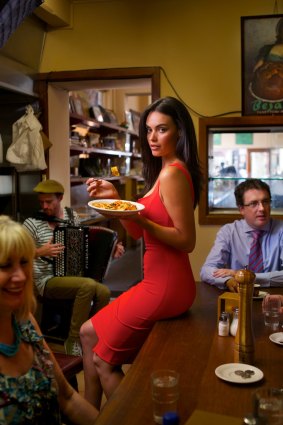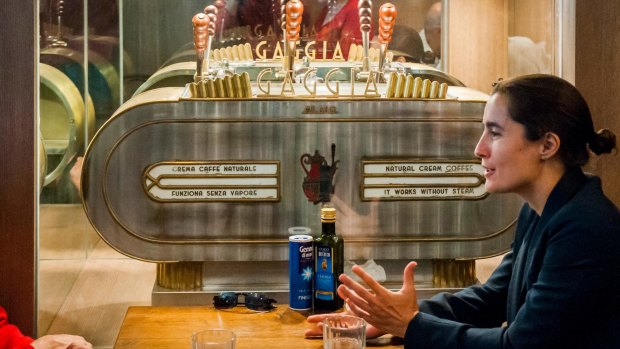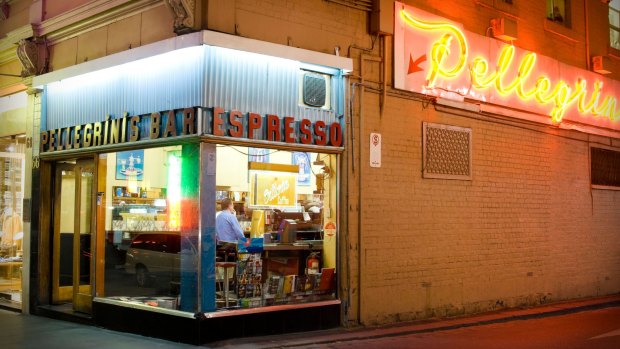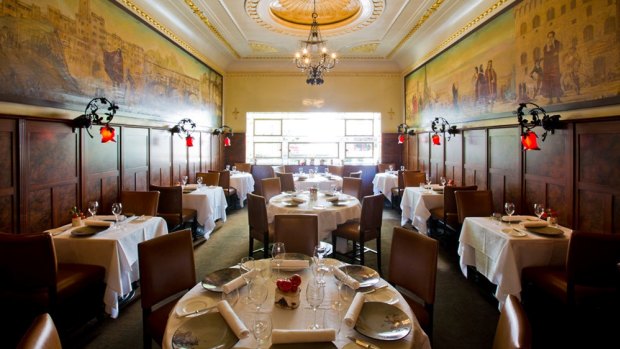This was published 7 years ago
Melbourne places to eat - best Italian cafes: How Melbourne became an Italian city outside Italy
By Anthony Dennis

Pellegrini's, with its long bar and red vinyl stools running the length of the cafe, opened in 1954. Model: Monika Clarke from Chadwicks.Credit: Simon Schluter
When I tell the waitress at the Italian Waiter's Club that it's more than two decades since I last visited the restaurant she replies, perfectly deadpan: "Well, you haven't missed much." Actually it has changed. A little. It's now called, less exclusively, The Waiters Restaurant, and the dining room has been tizzed-up with a stylised map of Italy on one wall.
But a steep flight of stairs off Meyers Place, which runs off Bourke Street, still lead to a plain white door. It suggests to outsiders, that this may be a no-frills massage parlour rather than a no-frills Italian food joint, albeit with an at times nefarious history.
It was here that in 1978, after all, that a 19-year-old man, Amos Atkinson, burst into the then Waiter's Club, armed with a sawn-off shotgun. He barricaded himself and about 20 other staff and patrons inside, demanding the release of his hero, the notorious Mark "Chopper" Read. "I was gripped by fear after [he] shot into the door frame but after that it became a waiting game," declared one of the hostages, sans irony.

Australia's oldest Gaggia coffee machine at the old-established University Cafe in Carlton, Melbourne.Credit: Alamy
John Silvester, The Age's legendary crime reporter and author, wrote that Atkinson had said if Read was not released within 24 hours he would start killing his captives. But he "lost interest" after four hours when his mother, a regular diner at the Waiter's Club, arrived to act as a go-between.
"She walked up the stairs in her dressing gown, ending the tense stand-off by hitting her son on the head with her handbag while telling him to stop being stupid. He then released his captives and surrendered," Silvester says.
"The siege was a heinous crime on many levels. But worse, the Waiters' was a Melbourne institution where reporters, politicians, detectives and the occasional Italian waiter could get a decent feed and a passable claret well after legal closing."

Pellegrini's Espresso Bar.Credit: Alamy
Far from being ashamed of the incident, the proprietors of the modern-day Waiters Restaurant still have faded front pages of the defunct Melbourne Herald, detailing the incident at Italian Waiter's Club, attached to the wall near the entrance.
When it first opened in 1947 (making it all of 70 years old this year), a little like an illegal brothel or casino, you were only allowed entry after providing a password and it helped if you were a waiter of Italian or Spanish heritage. The waiters, and others as Silvester points out, would frequent the restaurant, for a late-night feed and a sly drink and to play cards and wind down.
The Waiters Restaurant has never haunted the main sections of The Age Good Food Guide and almost will certainly never do so. But haute cuisine is not the purpose of this particular visit of mine to Melbourne. I'm a Sydneysider-cum-frustrated-Melburnian and I'm on a stroll down corsia di memoriam having lived in Melbourne for two years in the early to mid-1990s.

Mebourne's First Italian Espresso Bar, Pellegrinis.Credit: Alamy
I've visited it regularly ever since. One of my favourite aspects of this cosmopolitan city is its plethora of authentic, atmospheric and historic Italian restaurants, cafes and bars, many of which, like the Waiter's Restaurant, date as far back as the 1920s. No Australian city, Sydney included, can claim such a diverse range of ltalian-style eating and drinking venues of this kind.
Melbourne can at times deliver a persuasive impression of a European city, and even better, an Italian one. At its best, it can unquestionably count itself alongside the likes of Vienna, Rome and Budapest as one of the world's great cafe cities with its almost dysfunctional, well-documented ardour for coffee. It's no surprise, then, that Melbourne should be Australia's cafe capital, a city which seems powered as much by espresso as it is by electricity.
Such is the intensity of Melbourne's coffee preoccupation that when Robert Doyle, the city's lord mayor, remarked in passing a few years ago that "coffee is coffee; it's not life or death" the ensuing hissing noise from the caffeine cognoscenti was akin to that of a thousand espresso machines.

The opulent upstairs at Grossi Florentino.Credit: Alamy
He then bravely returned to the subject last year, outing himself not much of a coffee drinker. "I know this is sacrilege in Melbourne," he said. "It's like not having a footy team."
During my time living in Melbourne, when I felt the wrath for initially not having an AFL team while at least loving coffee, I enjoyed hanging out in cafes like Pellegrini's on Bourke Street, not far from the Waiters Restaurant.
Pellegrini's, which is nowadays heritage protected, with its long bar and red vinyl stools running the length of the cafe opened in 1954. The cafe's a short stroll from Victoria's Parliament House and partly due to its proximity to the state legislature it receives a diverse clientele. I learnt early on to eschew the indifferent food and concentrate on the excellent coffee and, for that matter, the old-fashioned ambience.
Although the Waiters Restaurant – as packed on the night I returned as the last time I visited those 20-odd years ago – has been modernised to a degree, Pellegrini's remains defiantly and utterly unchanged and unrenovated.
Melbourne's bohemian cafe scene can be traced all the way back to the late 19th century. Cafe Denat, among others, according to the Museum of Victoria, which even counts coffee artefacts in its collection, opened in 1893 and eventually became known as Florentino's.
The latter still exists today, just a few doors down from Pellegrini's, though coffee drinking in Melbourne can be traced even further back to the 1830s when the first temperance movement coffee houses and coffee palaces began to open. But it wasn't until the 1950s that espresso machines, as we know them today, began to appear in both Melbourne and Sydney.
When I lived in Melbourne I used to frequent Grossi Florentino's famous ground-level Cellar Bar, where you could always enjoy a decent, casual and affordable Italian meal and a glass of wine in attractive surroundings. The much posher upstairs restaurant at Grossi Florentino, with its opulent interior and its leadlight windows, is a recipient of two hats in The Age Good Food Guide with its waiters, sporting long white aprons and black vests, still laying on the Italianness as thick as the pizzas Australians used to eat before the discovery of thin crusts.
Downstairs in the Grill, reopened last year after a major refurbishment, the waiters make for a rousing sight in and around the restaurant's al fresco tables at the Roman end of Bourke Street as well as inside the establishment itself. There, in the Grossi Florentino Grill, tiramisu is theatrically served by your waiter directly from large bowls, tucked under arms, to your own bowl on your table. Outside of Italy itself there's nothing quite like it.
From this part of CBD, Lygon Street, Carlton, Melbourne's traditional Italian heartland, is within easy reach. Many Melburnians consider Lygon Street to be a bit gauche, especially the seedier, trashier city end – home of Toto's Pizza House, Australia's oldest dating to 1961 – where spruikers try and entice customers and the occasional gangster gets shot.
But Lygon Street, which features historical markers all the way along it, as a whole is much superior to Leichhardt, the Sydney equivalent, which has done little to preserve and highlight its own Italian heritage. On arrival in the city's true Little Italy on the next stage of my corsia di memoria, I am a bit saddened to discover that the University Cafe, which opened in 1952 and was named after the nearby University of Melbourne, had undergone a complete renovation.
But the owners have at least put on display, in pride of place in the middle of the cafe, one of the earliest Gaggia espresso machines to be imported from Italy to Australia, the coffee equivalent, more or less of a Model-T Ford.
Not far away from the University Cafe is the Lygon Food Store, which opened in 1952 while further along is the dark, wood-panelled Tiamo which has expanded into the next-door property. Elsewhere on Lygon Street, is Grinders Coffee, which was opened in 1962 by the pioneering Giancarlo Guisti and Rino Benassi. Guisti bought his famous big red roaster for just one pound and began roasting, grinding and selling beans from the store.
Who knows? The late Chopper Read, who was always full of beans, may have popped in, though he probably felt more at home down the dodgy end of Lygon.
FIVE MORE CLASSIC MELBOURNE ITALIAN CAFES AND DINERS
BRUNETTI, CARLTON
Brunetti opened in Faraday Street, Carlton, just off Lygon Street, in 1985, but has since moved around the corner on the main drag to much larger and flashier premises. This grand pasticceria, gelateria and cafeteria is a local institution. You'll think you're in Milan not Melbourne. See brunetti.com.au
MARIOS, FITZROY
A genuine Melbourne Italo-Australian institution, Marios is situated in inner-city Fitzroy and was opened in 1984. Founded by two men with the same first name (Mario) it sells Italian comfort food, done with panache, for lunch and dinner, and is renowned for its breakfasts. One of its most distinctive features is the natty waitstaff decked out in waistcoats. See marioscafe.com.au
BECCO, CITY
Located on Crossley Lane, which runs off Bourke Street just down from Pellegrini's, Becco is another Melbourne restaurant that could be straight out of Italy. In fact, it used to be the rear restaurant section of Pellegrini's before it was sold off. There's classic fare in the restaurant as well as an excellent bar. See becco.com.au
CAMPARI HOUSE, CITY
Originally another of Melbourne's old-school timber and terrazo ltalian cafes, Campari was opened in 1968. Located in Hardware Lane, off Bourke Street, all three levels of its building were converted into a funky eatery, lounge and rooftop bar in 2010 but hints of its past remain. See camparihouse.com.au
IL SOLITO POSTO, CITY
Melbourne's cool winters and dark laneways nicely lend themselves to basement-style restaurants and cafes. This long-standing enoteca, trattoria and cafeteria, off the so-called Paris end of Collins Street, is a great and cosy venue for soaking up Italian atmosphere. See ilsolitoposto.com.au
TRIP NOTES
MORE
EAT AND DRINK
Waiter's Restaurant, 20 Meyers Place, City, phone 03 9650 1508; Pellegrini's Espresso Bar, 66 Bourke Street, City, phone 03 9662 1885; Grossi Florentino, 80 Bourke Street, City, phone 03 9662 1811, see grossiflorentino.com; Toto's Pizza House, University Cafe, 257 Lygon Street, Carlton, phone 03 9347 2142, see universitycafe.com.au; Tiamo, 303 Lygon Street, Carlton, phone 03 9347 5759; Grinders, 277 Lygon Street, Carlton, phone 03 9347 7520, see grinderscoffee.com.au
TOUR
A local coffee industry identity, Maria Paoli runs private tours of Melbourne's historic Italian cafes tracing the city's espresso culture evolution from the mid-1950s. See melbournecoffeetours.com.au
STAY
381 Cremorne is a contemporary boutique-style apartment hotel located on the fringe of the CBD at the inner-city suburb of Cremore, near Richmond. Phone 0468 410 005. See 381cremorne.com.au
Anthony Dennis travelled a guest of Tourism Victoria and 381 Cremorne
See also: Get outta town: top 10 Melbourne day trips
See also: Six of the best Melbourne laneways
Sign up for the Traveller Deals newsletter
Get exclusive travel deals delivered straight to your inbox. Sign up now.